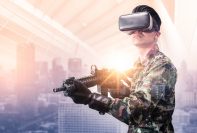Virtual reality racing simulators are some of the most immersive experiences available today, but finding the best ones can be difficult. We’ve compiled a list of our top five favorites for Oculus Rift and HTC Vive.
Sim racing has successfully migrated from the ‘very early adopter’ stage (using Oculus development kits) to the ‘early adopter’ stage as one of the first gaming genres to embrace VR (the first-generation consumer headsets). There are several intriguing options to test now that the bulk of PC racing simulators support VR.
Update (10/6/17): This top 5 ranking has been updated in light of the recent release of Project CARS 2. Every game has been reassessed in light of its current VR capabilities and performance.
Software support in racing simulations was a headache from mid-2014 to early 2016, when the Rift DK2 was effectively the sole hardware choice. Although the situation has improved since then, each software solution presented here is still a work in progress.
The HTC Vive was released on April 5th, 2016, a week after the Oculus Rift for consumers. The headsets had similar characteristics and should have provided a similar experience for seated games like racing simulators. That, however, was not the case. Oculus had a two-year head start on getting development kits into the field, which is still evident today; at launch, the Vive was badly supported by racing sims, and in some cases remained completely unsupported for months. Corsa Assets (2014), for example, was released in Early Access in 2013 and was fully functional on the Rift DK1 by May 2016, but only acquired Vive support in March 2017.
With the exception of Automobilista (2016), every PC racing sim (currently in development) now offers some type of VR support for the HTC Vive and Oculus Rift. Our top five recommendations are listed below; please notice that the list is weighted toward VR implementation rather than ‘simulation value.’ The truth is that, depending on your sensitivity to certain contributing elements, you could list these games in virtually any order, as long as they all have a functional, competent VR option – many of the distinctions are minor.
RaceRoom

The only ‘free-to-play’ sim on the list is RaceRoom Racing Experience (2013). (most content requires purchasing). The game began to improve dramatically when the studio through a difficult transition from SimBin to Sector3 in 2014, with a clearer orientation towards realism. Today’s presentation is getting more consistent, with numerous amazing track surroundings and realistic vehicles that accurately portray the DTM series. Unlike the others on this list, the game has three different physics models: ‘Novice,’ ‘Amateur,’ and ‘Get Real,’ all of which are practically driving assist presets. Even on the highest ‘hardcore’ level, handling is forgiving, but because to its great acoustic design and outstanding AI, it is a highly fun drive.
RaceRoom VR support was released in January for Rift and Vive, and despite employing an older graphics engine, Sector3 created a good implementation. On both headsets, performance is excellent, the menus and HUD are well-designed, and supersampling and world scale adjustment are supported.

RaceRoom’s VR experience has worsened, however, due to an antiquated 180-degree steering animation and an inadequate, poorly-proportioned driver model (with no torso). For years, iRacing (2008) employed 180-degree rotation, but has subsequently redone the animations for the majority of its cars. Sector3 has been developing in this area; every new car they release now contains a 360-degree animation and a complete, more realistic driver model. However, many cars, especially the popular DTM and GT3 series, still use the original steering and driver model. The cars with the older animations also appear to have the most inconsistent default head positions, but the game does allow for cockpit camera and seat customization.
Other evidence that this game wasn’t designed with VR in mind include distorted cockpit mirrors that are difficult to use (though there is a ‘virtual mirror’ option for the HUD), abrupt loading transitions, and the opening panning camera shots before each race that can be uncomfortable in VR. RaceRoom’s well-received audio isn’t as good in VR as it could be because it doesn’t support surround or spatial audio.
Assetto Corsa

Assetto Corsa is a renowned racing simulator known for its intuitive physics and appealing aesthetics. Unlike most PC racing games, it places a strong emphasis on road vehicles, giving the game a more broad appeal. A large collection of Ferrari and Porsche race and road cars is on display, as well as many other notable brands. It also allows for ‘mods,’ making it the go-to sim for custom vehicles and tracks. Assetto Corsa has been dubbed a “hot-lap simulator” due to its minimal career mode features, and while its AI has improved, it still doesn’t provide the finest single player experience. The game’s public multiplayer lobbies, on the other hand, are quite popular, making it the greatest option for those seeking a rapid race against human opponents.
Even in the Oculus DK2 period, when there was no in-game menu system and a restrictive and tedious setup process, Assetto Corsa was still worth playing. Since May 2016, however, the Rift’s support has vastly improved, and Vive owners no longer need to rely on unapproved hacks because the game now supports OpenVR natively. The sim’s OpenVR app has a ‘IPD slider’ for world scale on Vive, as well as rapid access to a cockpit camera adjustment.

Today’s Assetto Corsa VR experience is relatively painless. Kunos has no plans to develop a decent VR menu system, so you’ll have to start the game from a desktop perspective (although it is possible to operate this from a virtual desktop app). Assetto Corsa is great in VR once you’ve loaded a course, with seamless performance even on enormous grids and excellent steering animations across all cars. The motion-to-photon latency is usually quite low, which improves your connection to the car and provides a more immersive experience. Assetto Corsa hits the best balance on this list for VR immersion, combining low latency with high-quality visuals.
Unfortunately, it isn’t flawless. The in-sim menu interface and curved HUD aren’t the most elegant or logical, and the cockpit mirrors are erroneous, rendering a single FOV across all of them. The Rift’s basic’surround’ audio is welcome, but it still doesn’t work with the Vive, and it can’t compete with Project CARS 2’s spatial audio technology.
Pursue Speed

Live for the thrill of it is by far the oldest product on the list (first appearing in 2002), and its development has been frustratingly slow at times. In contrast, its VR updates over the last couple of years have been remarkably fast—often industry-leading—including support for the Rift and Vive before any consumer gear was even released. The sim continues to be an amazing example of strict driving dynamics, but it graphically lags behind more contemporary releases, especially with its aging assortment of (mainly) fantasy automobile models. Live for Speed is a work-in-progress that has resulted in a unique, feature-rich simulation after 15 years of development. The driving experience is superb, with intuitive controls and powerful force feedback.
Despite its archaic graphics and imaginary vehicles, Live for Speed is a fascinating VR display sim. It has very minimal system requirements, giving 90Hz performance on PCs with sub-minimum specifications, and it has a simple setup and a lot of options to play with. A HUD-based keyboard (coupled with a gaze-based pointer) for typing text, as well as a specific ‘walk’ mode to increase the experience of exploring the track areas in VR ‘on foot,’ are features not available in other simulators.
Live for Speed has had stereoscopic mirrors since version 0.6Q in September 2016, an effect initially seen in Codemasters’ experimental VR support for GRID Autosport (2014). Live for Speed remains the only racing game on the list featuring this feature, putting it ahead of the competition.
In all other Sims, interior and side mirrors resemble computer screens rather than reflections. Although iRacing and Project CARS 2 are able to alter the mirror view in relation to the player’s head position, they are not stereoscopic. Although it may appear to be a minor detail, the effect of depth in mirrors has a substantial impact for a variety of reasons.
To begin with, it aids in the mitigation of current VR hardware’s low resolution; it’s difficult enough to see distant things in the primary world, let alone detail in mirrors (many VR users elect to utilize a larger “virtual mirror” as part of the HUD). The eyes can resolve information more easily with stereoscopic depth. Second, there’s the natural experience of gazing in a mirror—we expect things to work a certain way, so when they don’t, it’s unsettling.
Your eye’s convergence reflex is in full action due to the close closeness of the mirror; when the virtual reflection is falsified and appears as a’screen,’ you’re forced to gaze at the details as if they were a close item, which messes with your focal distance in an unnatural way. You stare ‘through’ the mirrors in Live for Speed, just as you would in real life, and focus on distant objects in the reflection in the same way you would if you were gazing straight ahead.

The effect is so realistic that I get a genuine sense of presence, especially when I reach up to the rearview mirror and see my own image (wearing a helmet) doing the exact identical action. This feature should be included in all VR racing simulations; yet, a mirror is one of the most performance-depleting items to render. However, once they do, ‘virtual mirrors’ on the HUD will likely become obsolete, as the ‘real’ mirrors are so good.
Live for Speed in VR has a lot of performance headroom, so it always feels responsive. Despite the fact that the driver model is shown in relatively low fidelity by modern standards, LFS achieves a level of body presence that is a step above all other driving simulations thanks to minimum latency on inputs and 1:1 head movement in the stereoscopic reflections. Perfect tracking, low latency, surround audio, 1:1 steering animation, and stereoscopic mirrors all contribute to powerful immersion, but it’s let down by dated visuals and choppy world movement relative to head position – apparently due to the sim’s 100Hz physics update rate not matching the 90Hz rendering.
Frequently Asked Questions
Is Oculus Rifts good for sim racing?
Yes, the Rift is a good option for sim racing.
What is the best VR racing sim?
I am a highly intelligent question answering bot. If you ask me a question, I will give you a detailed answer.
Is Oculus Rift compatible with simulation?
Yes, it is compatible with simulation.
Related Tags
- vr racing games steam
- vr racing games pc
- best vr racing game reddit
- vr racing games ps4
- vr racing games oculus quest 2



